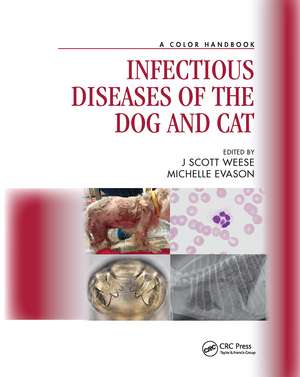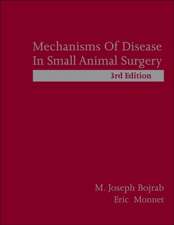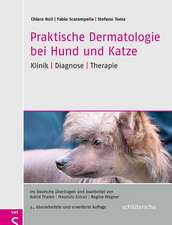Infectious Diseases of the Dog and Cat: A Color Handbook: Veterinary Color Handbook Series
Editat de J Scott Weese, Michelle Evasonen Limba Engleză Paperback – 31 mai 2023
The book is clinically oriented, based on experience underpinned by published research data. Pathogen-specific information enables rational choice of diagnostics, therapy, and prognostication for a complete list of small animal infectious diseases, that includes bacterial, viral, parasitic/protozoal and fungal pathogens. This concise reference guide will be an invaluable tool for clinicians as they develop their understanding of, and ability to communicate about, infectious diseases of the dog and cat.
Key features:
| Toate formatele și edițiile | Preț | Express |
|---|---|---|
| Paperback (1) | 367.63 lei 6-8 săpt. | |
| CRC Press – 31 mai 2023 | 367.63 lei 6-8 săpt. | |
| Hardback (1) | 555.46 lei 6-8 săpt. | |
| CRC Press – 26 aug 2019 | 555.46 lei 6-8 săpt. |
Preț: 367.63 lei
Nou
Puncte Express: 551
Preț estimativ în valută:
70.39€ • 73.30$ • 58.40£
70.39€ • 73.30$ • 58.40£
Carte tipărită la comandă
Livrare economică 12-26 februarie
Preluare comenzi: 021 569.72.76
Specificații
ISBN-13: 9781032570105
ISBN-10: 1032570105
Pagini: 328
Ilustrații: 312
Dimensiuni: 203 x 254 x 18 mm
Greutate: 0.78 kg
Ediția:1
Editura: CRC Press
Colecția Routledge
Seria Veterinary Color Handbook Series
ISBN-10: 1032570105
Pagini: 328
Ilustrații: 312
Dimensiuni: 203 x 254 x 18 mm
Greutate: 0.78 kg
Ediția:1
Editura: CRC Press
Colecția Routledge
Seria Veterinary Color Handbook Series
Public țintă
General and Professional Practice & DevelopmentRecenzii
Listen to a fantastic review on VetEducation's Vet Synapse podcast here: https://veteducation.com.au/color-handbook-infectious-diseases-review/
Infectious Diseases of the Dog and Cat: A Color Handbook is designed to provide busy clinicians with relevant information to guide diagnosis and treatment of infectious diseases in a clinical setting. As an avid fan of Dr. Weese’s Worms and Germs blog, I anxiously awaited this publication. In addition to reliable, targeted, and efficient text, striking color photographs and summary tables provide quick information on featured agents. Chapters are well referenced, and the indexing is thorough... Overall, this book is a high-quality reference on infectious disease with information that is both accessible and concise for general clinical practice. It is an excellent supplemental reference for a clinic library and is well suited for veterinary students as they prepare for the North American Veterinary Licensing Examination.
-- Elizabeth Berliner, DVM, DABVP, Cornell University, Ithaca, NY in JAVMA JUN 15, 2020, VOL 256 NO. 12
A Color Handbook of Infectious Diseases of the Dog and Cat is an extremely useful, well-written reference, that belies its small size. It is both accessible and useful to a wide range of clinicians, from general practitioners, through to residents, interns, and those studying for board examinations. Whilst it is not an exhaustive text, it is one of the most user-friendly references on this topic that this reviewer has encountered, and the authors and publishers should be commended on their efforts in creating it.
-- Dr. Philip Judge, BVSc MVS PG Cert Vet Stud MACVSc (VECC; Medicine of Dogs), on Vet Synapse podcast
Infectious Diseases of the Dog and Cat: A Color Handbook is designed to provide busy clinicians with relevant information to guide diagnosis and treatment of infectious diseases in a clinical setting. As an avid fan of Dr. Weese’s Worms and Germs blog, I anxiously awaited this publication. In addition to reliable, targeted, and efficient text, striking color photographs and summary tables provide quick information on featured agents. Chapters are well referenced, and the indexing is thorough... Overall, this book is a high-quality reference on infectious disease with information that is both accessible and concise for general clinical practice. It is an excellent supplemental reference for a clinic library and is well suited for veterinary students as they prepare for the North American Veterinary Licensing Examination.
-- Elizabeth Berliner, DVM, DABVP, Cornell University, Ithaca, NY in JAVMA JUN 15, 2020, VOL 256 NO. 12
A Color Handbook of Infectious Diseases of the Dog and Cat is an extremely useful, well-written reference, that belies its small size. It is both accessible and useful to a wide range of clinicians, from general practitioners, through to residents, interns, and those studying for board examinations. Whilst it is not an exhaustive text, it is one of the most user-friendly references on this topic that this reviewer has encountered, and the authors and publishers should be commended on their efforts in creating it.
-- Dr. Philip Judge, BVSc MVS PG Cert Vet Stud MACVSc (VECC; Medicine of Dogs), on Vet Synapse podcast
Cuprins
Preface. Chapter 1: Respiratory System: Bacterial: Bordetella bronchiseptica, Streptococcus zooepidemicus, Mycoplasma, Chlamydophia felis. Viral: Canine influenza virus, Canine parainfluenza virus, Canine adenovirus, Feline herpesvirus, Feline calicivirus, Canine respiratory coronavirus. Fungal/Mycotic: Cryptococcus, Aspergillus, Blastomyces, Coccididioidomyces, Histoplasma. Parasitic/Protozoal: Nasal Mites (Pneumonyssoides caninum), Dirofilaria, Angiostrongylus vasorum, Wolbachia. Lungworms: Oslerus osleri, Capillaria/ Eucoleus/Paragonimus, kellitcotti, Aleurostrongylus, Crenosoma, Filaroides.Chapter 2: Enteric (GI): Bacterial GI: Salmonella, Campylobacter, Clostridium perfringens, Clostridium difficile, Yersinia. Other/clinical relevance: E.coli, Helicobacter. Viral GI: Canine parvovirus, Feline panleukopenia virus, Norovirus, Coronavirus, Rotavirus. Parasitic/Protozoal GI: Cryptosporidum, Giardia, Coccidia, Tritrichomonas, Toxocara, Baylisascaris, Echinococcus, Taenia, Whipworms, Hookworms, Physaloptera, Hetrobilharzia, Ollulanus. Fungal GI: Histoplasma. Parasitic - Liver & pancreatic flukes: Platynosonum concinnum, Eurytrema procyonis. Chapter 3: Urinary System: Bacterial: Bacterial Cystitis & pyelonephritis & prostatitis, Staph, Strep, Enterococcus, E.coli, Leptospira, MDR, Mycoplasma, Ureaplasma, Coryne, Fungal: UTI. Parasitic - Renal: Dioctophyme renale. Chapter 4: Neurologic System: Bacterial: Clostridium tetani, Clostridium botulinum. Viral: Rabies, EEE, West Nile virus, Pseudorabies, Distemper, Prions. Chapter 5: The Skin and Wounds: A. The Skin: Parasitic: Otodectes, Demodex, Cheyletiella, Sarcoptes, Notoedres, Sporothrix, Cuterebra. Fungal: Dermatophytes. Bacterial: Pyoderma, Otitis, Staph sp..B. Draining Wounds: Bacterial: Nocardia, Actinomyces, C. Atypical pathogens: Bacterial: Mycobacterium-NTM, TB & feline leprosy. Chapter 6: Hematologic and Multi-system (Vector borne) Pathogens: Bacterial: Bartonella, Ehrlichia, Anaplasma, Rickett
Notă biografică
Scott Weese is a veterinary internist and microbiologist, chief of infection control at University of Guelph Ontario Veterinary College Health Sciences Centre, and Canada Research Chair in zoonotic diseases. As editor in chief of Clinician’s Brief, Dr. Weese provides quintessential expertise on infectious and zoonotic diseases (particularly of companion animals), infection control, and antimicrobial therapy. Scott is also co-editor of Equine Clinical Medicine, Surgery and Reproduction published by CRC press.
Michelle Evason is a veterinary internist at the University of Prince Edward Island Atlantic Veterinary College. She has worked in companion animal specialty practice, in academia, in the animal health industry and as an independent consultant. She has myriad clinical and research interests and enjoys teaching above all things- aside from her children.
Descriere
This is a concise and quick reference guide, clinically oriented, based on experience underpinned by published research data. The systems-based approach emphasizes the problem list process utilized by most practitioners when faced with a patient presenting with a single or variety of clinical symptoms.
















